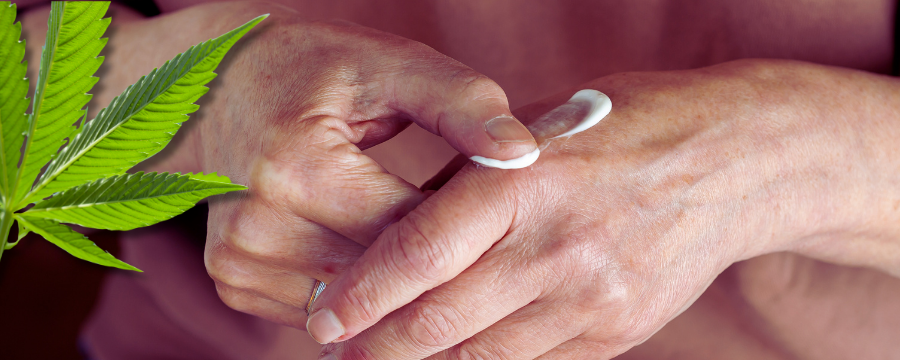- Texas Medical Cannabis Dispensaries vs Hemp Stores
- 5 Easy Steps to Fill Your Prescription
- Decoding Texas Cannabis Ratios: 20:1, 1:1, 0:1…
- Dosing & Product Education
- Texas CUP News & Legislation
- Conditions & Symptom Relief
- Practice Updates & Patient Stories
- Caregivers & Family Support
- Compliance & Legal FAQs
- Texas Medical Cannabis Guidebook 📚
- Complete Learning Library 📚
CBD Lotions & THC Patches 101: Are Topicals Right for Your Pain?

👀 Topicals Are Everywhere—But Are They Effective?
You’ve probably seen CBD creams at the store or heard about THC patches for arthritis. They’re marketed as quick, safe, and targeted—but are they legit?
At Floweret MD, we get a lot of questions about topical cannabis products, especially from patients who want relief without the side effects of oral THC. Many are surprised to learn that yes—topicals can be a valuable part of a low-THC treatment plan, especially for pain, inflammation, and muscle stiffness.
But not all topicals are created equal—and they don’t work the same way as tinctures or capsules.
💡 Why Topicals Deserve a Spot in Your Toolkit
Topical products like lotions, creams, balms, and patches deliver cannabinoids through the skin, targeting specific areas without affecting the whole body.
That means:
-
No “high” or sedation
-
Little to no systemic absorption (unless transdermal)
-
Ideal for localized pain—joints, neck, back, or injury sites
THC topicals (available under Texas CUP) are often paired with CBD for anti-inflammatory benefits. Some are designed to stay on the skin’s surface, while others (like transdermal patches) are meant to deliver cannabinoids into the bloodstream for longer, steadier relief.
For patients who want symptom control without full-body effects, topicals are often the missing piece.
✅ What Patients Experience When They Try Topicals
Topicals can’t treat every condition—but when used correctly, they can:
-
Reduce arthritis stiffness in hands, knees, or shoulders
-
Calm nerve-related tingling or post-surgical tenderness
-
Help manage muscle soreness after physical therapy
-
Serve as a gentle introduction to cannabis for first-time users
-
Support other medications by reducing localized flare-ups
We’ve seen patients with autoimmune joint pain, fibromyalgia, and even diabetic neuropathy benefit from topical routines—especially when combined with an oral product at night.
🧴 How to Choose the Right Topical (And Use It Effectively)
Here are a few tips to help you get the most from your cannabis creams and patches:
🧪 1. Check the Label
Look for:
-
Clear ratios (e.g., 4:1 CBD:THC or 1:1 CBD:THC)
-
Active cannabinoid content per dose (e.g., 100mg CBD per jar and 100mg THC per jar)
-
Lab-tested, CUP-approved brands for medical use
⏳ 2. Give It Time
Most topicals take 15–30 minutes to work and may need to be reapplied every 4–6 hours. Patches often last 8–12 hours but should be worn consistently to maintain relief.
🔒 3. Store Safely
Keep creams in a cool, dark place and patches sealed in their original packaging. Make sure products are out of reach of kids and pets.
💡 4. Pair It with a Holistic Plan
Topicals work best when used alongside your oral regimen—not as a replacement unless your provider recommends it.
📌 Final Thought
Topicals aren’t a gimmick—they’re a smart tool for patients who want targeted relief without full-body effects. Whether you’re easing sore joints or exploring new ways to support your condition, there’s likely a topical that fits your needs.
💬 Want help choosing a topical for your condition?
Let’s find the right formula for you.
➡️ Book a telehealth visit or ask about product recommendations during your next refill.
Relief doesn’t have to come in a dropper—it might come in a topical balm.
This content is educational and not medical advice. Consult a qualified healthcare professional before starting, changing, or stopping any cannabis or other treatment.
References
-
U.S. Food & Drug Administration – Cannabidiol (CBD): What You Need to Know.
https://www.fda.gov/consumers/consumer-updates/what-you-need-know-and-what-were-working-find-out-about-products-containing-cannabis-or-cannabis -
Maida, V., & Corban, J. (2008). Topical Medical Cannabis: A new treatment for wound pain—Three cases. Journal of Pain and Symptom Management, 56(6), e1–e2.
https://doi.org/10.1016/j.jpainsymman.2018.09.013 -
National Center for Biotechnology Information – Transdermal delivery of cannabinoids.
https://pubmed.ncbi.nlm.nih.gov/29506404



